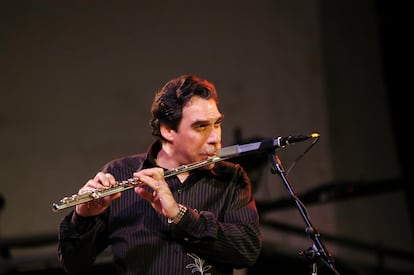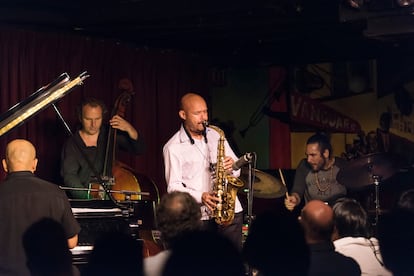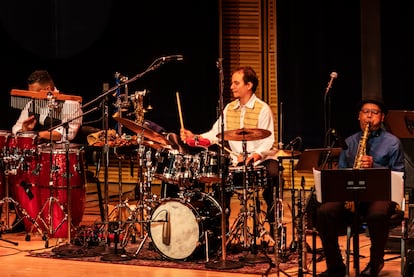Who’s afraid of Latin jazz? A burgeoning sound and identity
Latin jazz — it’s a term that describes a unique cultural phenomenon and movement in the world of music, where concepts such as identity, language, and marketing come into play.


Melodic fluidity, joyful flutes, lively rhythms, and sensual bass beats beneath captivating songs — all executed to perfection. For decades, Latin jazz has been one of the most enjoyable and beloved musical offshoots of the industry. However, some people in the US Hispanic community have an issue with the term “Latin jazz” and its connotations.
The sweet and poetic images of bossa nova first joined the tropical beauty of samba with the melodic jazz of North America. The great Latin American migration to the United States during the 1930s and ‘40s spread and expanded the bossa nova sound, followed by Afro-Cuban jazz, Latin jazz, and salsa.
Latin jazz is proof that music is a living language that is constantly moving, conversing, and mixing with practically everything — language, identity, culture, instruments, and even socio-historical contexts, and processes. But Latin jazz, viewed as new and fresh for many years, is now embroiled in some slippery and contentious issues, whether it comes from Brazil, Cuba, or the United States,
The powerful performances and virtuosity of legendary musicians like Eddie Palmieri, Paquito D’Rivera, Arturo Sandoval, Mongo Santamaria, Irakere, Bebel Gilberto, and Sabú Martínez have given way to a Latin jazz sound in which the creative and stylistic freedom of jazz has been replaced by safe, pasteurized, and rigid forms that seem tired and outdated.
Some of the harshest critics call it “elevator music,” or “hotel lobby music.” For some, Latin jazz is yet another cultural appropriation by Anglos rather than a living expression of Hispanic identity that reflects its environment. It’s a category fabricated by the music industry that is useful for award ceremonies and marketing campaigns. How true is this?

The music industry recognized the issue and decided to eliminate the category from the 2011 Grammy Awards. Predictably, this led to vehement protests from musicians and producers who huddle under the Latin jazz umbrella, and the category was eventually restored. However, this only aggravated the divide between the two camps of musical evolution versus institutionalism.
This was reaffirmed when the same people were nominated year after year for awards in the Latin Jazz category: pianist Chucho Valdés, bassist Andy González, and trombonist Wayne Wallace. Most of them are over 60 and have what is considered a classical style. In reality, Latin jazz is blossoming creatively these days, with musicians experimenting and branching out into new styles at a rapid pace. Perhaps the evolution of Latin jazz has been inspired by changes in other genres, like Bad Bunny’s domination of the music industry.

Professor Petra Rivera-Rideau says there is a broader discussion beyond these two perspectives, where concepts such as language, identity, and culture are interrelated and generate a myriad of worldviews. This means that there really is no clear-cut definition for Latin jazz. Rivera-Rideau says, “Part of what makes defining Latin music so difficult is that it encompasses a host of genres that are also quite complex. So for example, we might think of something like cumbia — there are many different styles of cumbia, many different ways the music has evolved over time, and many different histories and geographies tied to cumbia, whether it’s in Mexico or in Colombia or among Mexican Americans.”
The US music industry seems clear about what Latin jazz is — at least 51% of the lyrics must be in Spanish or Portuguese. This doesn’t seem very useful, considering that language crossovers are practically the rule today. Moreover, much of contemporary jazz is almost completely instrumental. Does the problem become one of how to categorize the influences, mixtures, and sound interactions? The Hispanic community doesn’t seem to have the answer.
Fortunately, following in the footsteps of greats like Chano Pozo, Machito, Carlos Jobim, and Gato Barbieri is an abundance of young and captivating musicians who are renewing and injecting creativity into a music style built on Hispanic cultural foundations, while exhibiting an elegance, technical virtuosity, and sophistication typical of Latin jazz.
Younger musicians like Pedrito Martínez, Alfredo Rodríguez, Arturo O’Farrill, Yosvany Terry, Sr. Martínez, Román Díaz, and Ibeyi are expanding and enhancing the Latino identity in the world of jazz, making Latin jazz even more difficult to define, but also more interesting and enjoyable.
Sobre la firma
